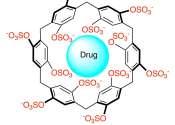Bioengineers close to brewing opioid painkillers without using opium from poppies
For centuries poppy plants have been grown to provide opium, the compound from which morphine and other important medicines such as oxycodone are derived.

For centuries poppy plants have been grown to provide opium, the compound from which morphine and other important medicines such as oxycodone are derived.
Biotechnology
Aug 24, 2014
5
0

(Phys.org) —Almost every biological process involves sensing the presence of a certain chemical. Finely tuned over millions of years of evolution, the body's different receptors are shaped to accept certain target chemicals. ...
Bio & Medicine
May 6, 2014
0
0

People with chronic pain are often dependent on drugs from the class of opioids with sometimes considerable side effects. Accordingly, in recent years the search for safer alternatives has been the focus of new drug discovery.
Biochemistry
Dec 6, 2023
0
20

Methamphetamine (meth) abuse is a major health concern. Understanding how meth interacts with its target proteins is crucial for the development of novel medications to address drug addiction. Previous research into the mechanism ...
Biochemistry
Nov 24, 2023
0
53

By rapidly reversing the effects of an opioid overdose, naloxone saves lives―if it's available at the right time. To eliminate this element of chance, researchers are exploring ways to have the medication available in the ...
Bio & Medicine
Nov 8, 2023
0
3

According to the Centers for Disease Control, 100,000 Americans die each year from an overdose, most due to the use of synthetic opiates like fentanyl. While naloxone, currently the only an antidote for opiate overdose, has ...
Biochemistry
Jul 18, 2023
2
45

In the continuing effort to improve upon opioid pain relievers, American and Chinese scientists used cryoEM technology to solve the detailed structures of the entire family of opioid receptors bound to their naturally occurring ...
Molecular & Computational biology
Jan 12, 2023
0
24

Drug overdoses in the United States have risen sharply in the last two decades. Nearly 92,000 people died from overdoses of illegal drugs and prescription opioids in 2020—more than five times the number of deaths in the ...
Biochemistry
Dec 15, 2022
0
425

Pain, especially chronic pain, is a common neurological phenomenon. The most common chronic pain conditions include low back pain, arthritis pain, migraine and cancer pain—all of which seriously affect people's physical ...
Biochemistry
Nov 16, 2022
0
94

New substances that activate adrenalin receptors instead of opioid receptors have a similar pain relieving effect to opiates, but without the negative aspects such as respiratory depression and addiction.
Biochemistry
Oct 4, 2022
0
33
An opioid is a psychoactive chemical that works by binding to opioid receptors, which are found principally in the central and peripheral nervous system and the gastrointestinal tract. The receptors in these organ systems mediate both the beneficial effects and the side effects of opioids.
Opioids are among the world's oldest known drugs; the use of the opium poppy for its therapeutic benefits predates recorded history. The analgesic (painkiller) effects of opioids are due to decreased perception of pain, decreased reaction to pain as well as increased pain tolerance. The side effects of opioids include sedation, respiratory depression, constipation, and a strong sense of euphoria. Opioids can cause cough suppression, which can be both an indication for opioid administration or an unintended side effect. Opioid dependence can develop with ongoing administration, leading to a withdrawal syndrome with abrupt discontinuation. Opioids are well known for their ability to produce a feeling of euphoria, motivating some to recreationally use opioids.
Although the term opiate is often used as a synonym for opioid, the term opiate is properly limited to the natural alkaloids found in the resin of the opium poppy (Papaver somniferum). In some definitions, the semi-synthetic substances that are directly derived from the opium poppy are considered to be opiates as well, while in other classification systems these substances are simply referred to as semi-synthetic opioids.
This text uses material from Wikipedia, licensed under CC BY-SA